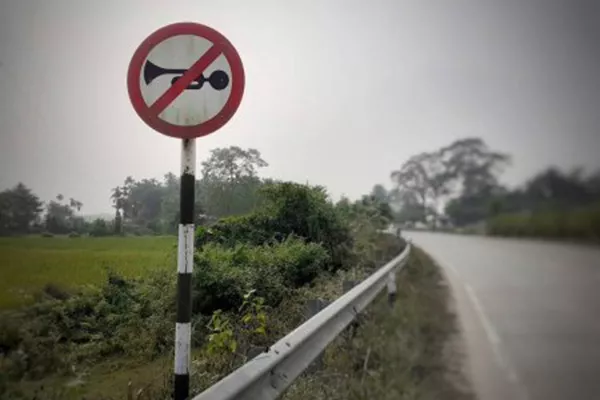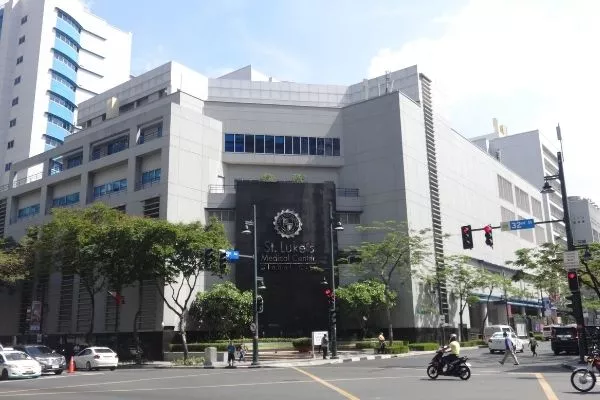In your journeys through the urban landscape or even through provincial roads, road signs are a common sight. All of them convey an important message and are meant to moderate our behaviors as drivers depending on the nature of a stretch of road. One of those signs is the “No blowing of horn.”

A typical "No blowing of horn" sign
Now some of you might simply obey this sign outright with no questions asked. Congratulations, you’re a law-abiding driver. But what does this sign even mean? What is its function and why do we have to respect it?
As it says on the tin, the No Blowing of Horn sign is regulatory signage that orders a driver entering a particular area to avoid using his/her car horn.
For the benefit of those who don’t know, blowing your car horn is meant to warn other drivers on the road. It is not for conveying your anger or your impatience. That however is a message that’s lost to some of our fellow motorists. In that vein, it is not used to chastise other drivers.

No, your car's horn was not installed to let you vent out
For smaller vehicles, a car horn is also useful for making other drivers aware of your presence. Even modern cars after all have several blind spots.
I. Where are “No Blowing of Horn” signs usually located?
No Blowing of Horn signs is usually located on roads adjacent to places where silence is required. These include places of learning like schools, as well as religious structures like chapels, mosques, and churches. Certain hospitals will also have this sign on nearby roads.
In some select instances, you can also find No Blowing of Horn signage near places that hold flag ceremonies, albeit these are only effective during a certain timeframe. Usually, these take effect early in the morning.

Schools regularly conduct flag ceremonies and require silence for a conducive learning environment
In the case of places of learning. Imagine being a student quietly concentrating on a difficult math problem only to be jolted by the incessant beeps and boops of car horns. For religious places, these need an atmosphere of solemn silence. For places when flag ceremonies are held, not blowing your car horn is a sign of respect to the national flag and our country’s national anthem.
And lastly, some patients admitted to hospitals will require peace and quiet. Also, loud noises actually have adverse effects on our health, especially those of some patients. More on that later.
There are also other nature reserve zones adjacent to roads here in the Philippines where car horn blowing is discouraged. This includes roads bisecting the Initao-Libertad Nature reserve, which is one of the homes of the very sound sensitive and very endangered Tarsier.

You wouldn't want to startle this cute guy, would you?
Apart from those aforementioned places, some residential areas might also have No Blowing of Horn signs for the benefit of its residents.
II. Penalties for not following the “No Blowing of Horn” sign
As per the Joint Administrative Order No. 2014-01, failure to follow traffic signs, in general, will net you a penalty of Php 1,000. For some areas where a No Blowing of Horn sign is located, it might fall under the jurisdiction of city or barangay ordinances so penalties might vary.
If it was found out that your vehicle is using a particularly loud noise-making device, this might also fall under “Unauthorized vehicle modification.” For this, you’ll have to pay a heftier Php 5,000.
>>> Related: Complete list of LTO fines and penalties in the Philippines
III. No Blowing of Horn: In relation to sound pollution
According to a World Health Organization (WHO) report, environmental noise is one of the modern world’s top risks to our health. Noise sources of course include car horns.
How does this affect our health? Well for some individuals, this might mean elevated stress levels, hypertension, and loss of sleep. It can even inadvertently lead to cardiovascular conditions. To this end, high levels of environmental noise including road noise will have adverse effects on patients recovering in the hospital. This is further exacerbated for patients recovering from those aforementioned cardiovascular problems and other major illnesses.

Hospitals like Saint Luke's is located near a busy road. So please, ration your horn use when nearby.
Noise pollution even has worse effects on children. According to a study called “Early Life Environmental Health” by Stephen Stansfeld and Charlotte Clark, environmental noise can cause an increase in hyperactivity symptoms.
Kids with exposure to harmful levels of noise might also show signs of learning problems pertaining to memory, reading, and cognitive skills. The study also shows that repeated exposure to high environmental noise also contributes to more stress for children.

People living within the vicinity of EDSA will know this pain. Some will get used to it, many others don't.
To this end, the WHO has suggested keeping road traffic noise below 53 decibels and 45 decibels at night.
That is a challenge though because most major cities here in the Philippines are compact. Meaning most residential areas are located just a few meters away from major thoroughfares. As such, it is up to us motorists to discipline ourselves.
As we’ve said before, your car’s horn is not a toy. Only use it when alerting other drivers. And no, it is not appropriate to use your car horn just to express how angry you are.
IV. “No Blowing of Horn” signage FAQs
Question: What does the “No blowing of horn” sign look like?
Answer: Like other road regulatory signs, the no blowing of horn sign has a horn symbol over a white field surrounded by a red circle with a red line running across the horn symbol.
Question: Where do I usually see “No blowing of horn” signages?
Answer: You can expect to see the “No blowing of horn” sign near religious buildings, schools, nature reserves, some residential areas, hospitals, near places where flag ceremonies are conducted, and some nature reserves.
Question: What is the penalty of disobeying the “No blowing of horn” sign?
Answer: Failure to follow road signs, in general, carries a fine of Php 1,000.
Question: How do I properly use my car horn?
Answer: Only use your car’s horn to warn other drivers of danger, and on narrow roads with blind curves.
Question: Do car horns contribute to noise pollution?
Answer: Yes. This is on top of the mechanical noise being emitted by your car. As such, we urge the proper use of car horns.
For more useful automotive-related guides, keep reading here on Philkotse.com.
Recent posts
- Illegal Parking Laws in the Philippines: How not to be a Parking Jerk Aug 25, 2021
- Car Accident Law Philippines: Everything Pinoy drivers should know & follow Aug 04, 2020
- The importance of abiding traffic lights and road signs Aug 16, 2022
- A Deeper Understanding of the Different Road Signs in the Philippines Apr 24, 2020
- Speed Limit Law Philippines: Know It, Follow It Jan 05, 2021












